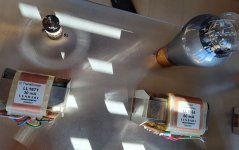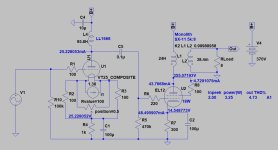Interesting discussion.
I believe that quality of transformer or plate choke is critical for good sound, and generalizations as to which topology sounds better should be be made with caution.
Objectively, Hammond chokes are poor quality. To begin with, they were designed as power supply chokes, not as plate chokes. Measures are not taken to reduce winding capacitance, so high frequency performance is compromised. Silicon steel core has high hysteresis, resulting in distortion of magnetizing current, which, in combination with relatively high plate resistance, causes distortion of voltage waveform. Laminations are thick, which limits high frequency performance.
Lundahl plate chokes are better in several ways: they have low winding capacitance, thinner laminations (0.2 mm vs. 0.35 mm), and grain-oriented steel, which has lower hysteresis than regular silicon steel. The best are their chokes with amorphous core - very low hysteresis and very thin laminations.
From distortion perspective, RC is far inferior to good interstage transformer or plate choke.
I believe that quality of transformer or plate choke is critical for good sound, and generalizations as to which topology sounds better should be be made with caution.
Objectively, Hammond chokes are poor quality. To begin with, they were designed as power supply chokes, not as plate chokes. Measures are not taken to reduce winding capacitance, so high frequency performance is compromised. Silicon steel core has high hysteresis, resulting in distortion of magnetizing current, which, in combination with relatively high plate resistance, causes distortion of voltage waveform. Laminations are thick, which limits high frequency performance.
Lundahl plate chokes are better in several ways: they have low winding capacitance, thinner laminations (0.2 mm vs. 0.35 mm), and grain-oriented steel, which has lower hysteresis than regular silicon steel. The best are their chokes with amorphous core - very low hysteresis and very thin laminations.
From distortion perspective, RC is far inferior to good interstage transformer or plate choke.
It is true that Hammond chokes are inferior to real plate chokes but they can work surprisingly well as such. I´ve used 156C as a plate load several times when I've wanted to maximize gain and voltage swing from a triode gain stage, and in my latest project I use them instead of constant current sources in the tails of the LTP input stages.
Years ago I made a cathode follower amp where a 6CM4/EC86 with a 156C plate load provided over 300Vpp to the output stage.
Years ago I made a cathode follower amp where a 6CM4/EC86 with a 156C plate load provided over 300Vpp to the output stage.
Yes, with reservations at lowest and highest frequencies, where insufficient inductance and winding capacitance, respectively, may reduce gain.Gain with Choke load or interestage transformer 1:1 is similar ?
I was just looking at the calculation for plate chokes,
However, using these with 10Y looks like the bass will start to fall off at 70K. We assume Z = 4x Rp.
If we choose F = 40hz then the inductance needed at 4x Rp = 80H. So Lundahl LL1688 looks better gapped at 15 or 25mA (100H plus)
Questions
1. How severe is the roll-off below the chosen F?
2. Is 4x Rp a reasonable assumption? What if it's higher or lower?
| L = Z / (2 * pi * F). |
| I have a pair of Hammond 126B interstages 44H which I've used as plate chokes. These should work fine with 6C4C (6B4G) |
However, using these with 10Y looks like the bass will start to fall off at 70K. We assume Z = 4x Rp.
If we choose F = 40hz then the inductance needed at 4x Rp = 80H. So Lundahl LL1688 looks better gapped at 15 or 25mA (100H plus)
Questions
1. How severe is the roll-off below the chosen F?
2. Is 4x Rp a reasonable assumption? What if it's higher or lower?
A single L as load is a first order roll off - 6dB per octave.
An octave is doubling or, in this case, halving of frequency.
So if the cutoff F is 40 Hz, it's about 6dB down at 20Hz.
Jan
An octave is doubling or, in this case, halving of frequency.
So if the cutoff F is 40 Hz, it's about 6dB down at 20Hz.
Jan
I use Lundal 1671 , 35H primary SE to SE 1:1 , 1900ohms plate resistance D3a in triode mode 195v 21mA and have serious bass response. I use Two Subwoofers , between amp and speakers, using the high impedance input in the Subwoofers. Serious bass response, maybe 20 25hz.
Attachments
That can be hard to find.
If you put an air gap in a toroid, you loose all the advantages of a toroid. If you need an air gap it's better to use another type of transformer.
Jan
If you put an air gap in a toroid, you loose all the advantages of a toroid. If you need an air gap it's better to use another type of transformer.
Jan
Please take a look here: https://sklep.toroidy.pl/en_US/p/TTG-KT88PSE-Tube-output-UL-transformer-1,5kOhm-KT88-300B-PSE/589
They use "Distributed Air-Gap Powder Core" for their toroidals, and indeed they work well.
They also are very available to build custom items. That's why I wrote I'm pretty sure they can do plate chokes.
This is what I've found for "distributed air-gap", as I wasn't aware of it, but it's not related to toroidals:
https://www.psma.com/sites/default/...gy (Sadhab Ganda,Philipp Laurer, EPCOS).pdf
They use "Distributed Air-Gap Powder Core" for their toroidals, and indeed they work well.
They also are very available to build custom items. That's why I wrote I'm pretty sure they can do plate chokes.
This is what I've found for "distributed air-gap", as I wasn't aware of it, but it's not related to toroidals:
https://www.psma.com/sites/default/...gy (Sadhab Ganda,Philipp Laurer, EPCOS).pdf
If you see the assortment, only low-medium inductance power chokes available.
DC Anode chokes
As Jan wrote -even if distributed- the airgap degrading core overall properties.
Under such circumstances designing enough large impedance requires large/r/ turn counts. Case of toroidal core to solve linear operation on B-H curve and the many turns-low capacitance problem isn't easy job.
Making it the same as output SE transformers .... which can be sold for more, so worth it better.
DC Anode chokes
As Jan wrote -even if distributed- the airgap degrading core overall properties.
Under such circumstances designing enough large impedance requires large/r/ turn counts. Case of toroidal core to solve linear operation on B-H curve and the many turns-low capacitance problem isn't easy job.
Making it the same as output SE transformers .... which can be sold for more, so worth it better.
I'm thinking of ordering a pair of LL1668 chokes for my 10Y stage.
Could you recommend either 15mA = 167H or 25mA = 100H?
As far as I can see these plate chokes work best at lower than specified currents. So using the 15mA at 15mA might not be a good idea.
Could you recommend either 15mA = 167H or 25mA = 100H?
As far as I can see these plate chokes work best at lower than specified currents. So using the 15mA at 15mA might not be a good idea.
The LL1668/15mA has 167H inductance from my notes. The 25mA version is 100H. Not interested in the LL1667.
So which to choose for a 10Y? Looks like you prefer the 25mA version.....
So which to choose for a 10Y? Looks like you prefer the 25mA version.....
The more linear part of curves is between 20 and 30mA, if you use about 10k loadline.
The suggested -standing- 25mA for -series connected- LL1668 (40mA saturating) is good for 10Y/801a.
The suggested -standing- 25mA for -series connected- LL1668 (40mA saturating) is good for 10Y/801a.
- Home
- Amplifiers
- Tubes / Valves
- Plate chokes - choosing and using


